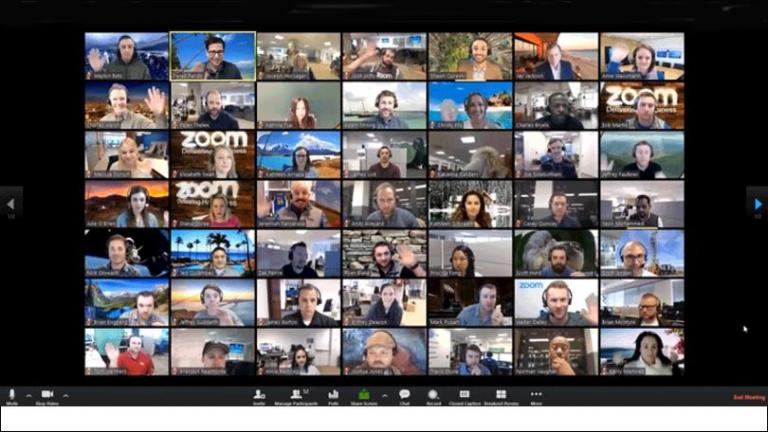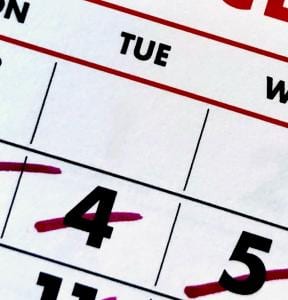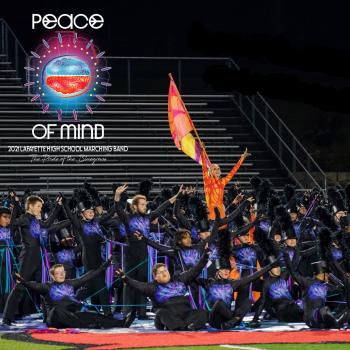At the beginning of the Age of Covid, the world rushed to videoconferencing as a way to stay connected and not lose valuable time for productivity. At first, we realized the many upsides of using platforms like Zoom or Go To Meeting. Things like, there’s no need to pop a breath-mint before entering the room. And it’s nice to just click a button instead of having to drive to a meeting. We delighted in realizing that we only had to be “dressed” from the waist up and could be in pajama bottoms and slippers below the camera. It’s also a neat experience to see everyone’s faces at once, to take in the whole group in one sweep of the screen.

You may have also observed some of the quirky aspects of meeting via videoconference. Have you noticed what I call the “Zoom hair check” – catching people adjusting their coif when their video first comes on? Seeing yourself on camera like that, you realize how others see you, including how that lock of hair is out of place.
Much of this is not new to me because I teach for a seminary that is already 90% online.
Our students only come to campus for in-person intensives twice a year. The rest of our curriculum consists of synchronous and asynchronous courses. This means that some classes are non-time-specific (asynchronous) with recorded Powerpoints and lectures, discussion boards, and tests. Students can access course content any time of the day or night as long as they keep pace with the weekly schedule.
Other courses are synchronous, meaning that we meet online using Zoom at a specific day and time each week. We use this platform for our Covenant Groups (faith formation). And I use it for a course I teach called Practice Preaching where students record their sermons that we watch on our own time and then meet on Zoom to discuss.
So at first, the transition to all-Zoom-all-the-time for every meeting didn’t seem like a big deal. I already knew how to do this. Not a problem, right?
But in these last few weeks, I’ve experienced something that maybe you can relate to as well.
I call it “Zoom Fatigue.”
It was my husband who first pointed it out. He teaches instrumental music lessons and has had to convert all his students to an online platform like Facetime. After his first day of several back-to-back lessons he emerged glassy-eyed and said, “I have a new appreciation for what you do. Teaching online is exhausting!”

I, too, have noticed how tired I’ve been feeling after a day “at work” where my interactions with people are primarily through online meetings. My brain is fried. I feel depleted.
Why does videoconferencing make us feel so tired?
It has to do with the way our brains process information.
* Videoconferencing requires a different kind of attention than in-person interactions.
Seeing everyone’s faces at once is a lot of “data” to take in. This is helpful in many ways because you can “read the room” more easily. But it also floods the brain with information it’s not used to handling all at once.
* Because of the barrier of a screen, we have to work extra hard to convey that we’re paying attention.
In an in-person face to face meeting, if one person is talking, you can look down at your notes, gaze out the window, or just look to the side while still paying attention. On screen, if we do these same things, we can see ourselves do it and we know it can imply that we’re not listening. So we try extra hard to pay attention. This is taxing on the brain and emotions.
* The screen forces us to use direct visual contact rather than supplement with our peripheral vision.
This is an adjustment for our brains that are used to picking up cues from the people around us without having to look right at them in an actual meeting. Again, this level of focus is not something we’re used to, and it can be taxing.
* Our brains are taking in the spaces of each person’s background.
In an in-person meeting where we all share the same room, our brains can tune out on the little details about the setting. In a videoconference, however, we notice all kinds of things about wherever the person happens to be Zooming in from. The artwork. The person walking behind them. The trees waving through the window of their screen porch. The pet who jumps up on their lap demanding attention (this happens more often than you might think). The kid who tugs at the sleeve wanting attention. We’re pulled in by each person’s challenges in their “working from home” environment, and as much as we try, it is hard to filter out that information.
* Our brains are trying to filter out our own background distractions.
Again, in a shared room in a neutral place (like a conference room), the details fade into the background. But at home, our brains are tempted to pay attention to the demands of the household (even with doors closed and family members held at bay). Because of these things competing for our attention, our brains are depleted by the end of the meeting.

So what can we do to prevent Zoom fatigue? How do we forestall videoconferencing burnout?
While I’m still learning this new way of working myself, I have learned a few things I can share.
1. Avoid scheduling Zoom meetings back-to-back.
It can be tempting to fill in blocks for meetings one right after the other knowing that you don’t have to travel to get to them. But your brain needs a break. Ideally, you should give yourself at least 30 – 60 minutes between meetings. You need that time to rest your eyes and brain. You also need time to use the bathroom and replenish your liquid and food fuel.
2. Allow or ask for breaks during Zoom meetings.
In the “normal” world, we know to give breaks during long meetings. Zoom is no different. 45 minutes is about as long as people can go without needing to empty bladders, fill stomachs, stretch legs, and rest eyes/brains. 5 – 15 minutes is usually enough time to break without losing momentum for the meeting. Especially if you have more than one meeting a day, you may need to schedule more frequent in-meeting breaks.
3. Look away from the screen during a Zoom break.
Don’t use the 5 – 15 minutes of break to check your email, text someone, look at Twitter, or post on Facebook. Encourage people to put their video and microphones on “mute,” leave the room, and go look at things far way. Look around the room. Gaze out the window. Because staring at a screen 2 feet away for long periods of time is not good for the eyes. They need to be able to focus on things at a distance in order to rest from short-distance viewing.
4. Remember that boundaries are still important.
I’m hearing some pastors say they feel that all boundaries they established have gone out the window in the Age of Covid. With visitations in the pre-Covid age, there was at least a car ride between home, church, and hospital to zone out and recharge. Now a parishioner knows you’re home. Because we all have to be home now. Unless you’re out on the front lines – in which case, God bless you, and I completely understand if you’re annoyed by this post complaining about Zoom-exhausted brains. (You may also be annoyed by this post if you’re one of the millions out of work right now. I hear that. Zoom-exhaustion seems a minor complaint in the face of massive unemployment.)
But we all still need to be aware of our “bubbles” – our time and space boundaries and how to protect and preserve them. If you’re finding that three or less meetings a day is all you can do, make that your limit.
5. Communicate by phone instead of videoconference.
Talking on the phone requires different – and sometimes less taxing – operations for your brain. By only having to concentrate aurally and orally, your visual processing is freed up. You can sometimes concentrate better by just listening instead of having to watch as well. This is why people like podcasts. And why kids who doodle and those who knit in church can still recall the content of a sermon – they’re listening in a different way, even if it seems they’re not paying attention. So if you would rather talk by phone instead of Zoom, say so.
6. Take a Zoom Sabbath
One of my students remarked that in the Age of Covid, time feels like an “endless Thursday.” There’s no weekend because every day is the same. People sometimes lose track of what day it is. The habits and rituals that used to mark our days and weeks have dissolved. So there needs to be one day when you’re allowed to be screen-free. You’re still supposed to take a day off from work – whatever that work now entails. If God took a day off (see Genesis Chapter 2), who are we to think we can keep pushing without limits?
Bonus: 7. Give yourself “buffer zones.”

Another thing I’m now doing (which I figured out after first writing this article) is to put “buffer days” on either end of an intense Zoom stretch. I’m physically x-ing out those days on my calendar as a visual hard-stop on my own scheduling. If someone wants to schedule a meeting for the day before or after one of those long meeting days, I say I’m booked. Which I am – with a day of decompression and self care!
So go easy on yourself, your work colleagues, your family, and your friends when it comes to videoconferencing. I love Zoom and am grateful for this technology that enables us to connect and work. But pace yourself and the people you interact with. We’re in this for the long haul. So go gentle into that Zoom screen!
Read also:
When Earth Demands Sabbath: Learning from the Coronavirus Pandemic
How to ‘Be Church’ in an Online Seminary: Environmental Education, Sustainability, Community

Leah D. Schade is the Assistant Professor of Preaching and Worship at Lexington Theological Seminary in Kentucky and ordained in the ELCA. Dr. Schade does not speak for LTS or the ELCA; her opinions are her own. She is the author of Preaching in the Purple Zone: Ministry in the Red-Blue Divide (Rowman & Littlefield, 2019), Rooted and Rising: Voices of Courage in a Time of Climate Crisis (Rowman & Littlefield, 2019), and Creation-Crisis Preaching: Ecology, Theology, and the Pulpit (Chalice Press, 2015).
Leah’s latest book is a Lenten devotional centered on Creation: For the Beauty of the Earth (Chalice Press, 2020).
Twitter: @LeahSchade
Facebook: https://www.facebook.com/LeahDSchade/













